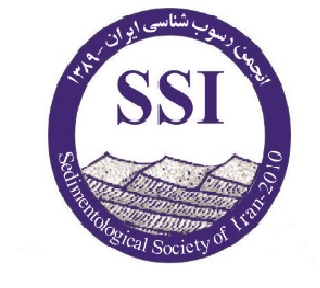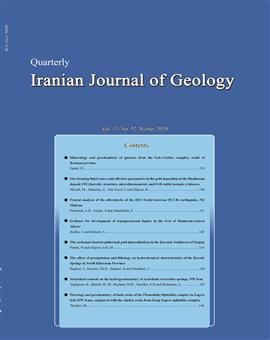The effect of precipitation and lithology on hydrochemical characteristics of the Karstic Springs in North Khorasan Province
Subject Areas :
Keywords: Lithology Karstic springs Hydrogeochemistry Precipitation, Northern Khorasan.,
Abstract :
Karstic aquifers are vital water resources which are used for irrigation and drinking purposes in arid and semi-arid regions. Understanding of the hydrogeological behavior of these springs and the qualitative tracing of these water resources are the first step in their better management. There are wide outcrops of Tirgan karstic formation in the study area, in the north of Khorasan province. In this area, there are a few karstic springs the discharge rate ranges from 50 to 500 lit/s. The recharge area characteristics of these springs vary significantly with their elevation, catchment size, thickness of epikarst and degree of karstification. In this study, temporal and spatial hydrogeochemcal variations of the five karstic springs including Arnaveh, Rezghaneh, Estarkhi, Ghordanlo and Sarani and 3 rain stations are investigated during one year period. The effects of both precipitation and lithology on the chemistry of these karstic springs are also considered. The dominant rain water types are Ca-SO4-Cl and Ca-HCO3 which change into Ca-Mg- HCO3 type during ground water flow in karstic system. This karstic aquifer is recharged during winter snowfall. The EC values of the rainfall vary from 70 µmohs/cm in Namanloo station to 100 and 150 µmohs/cm in Estarkhi and Ghale Barbar stations, respectively. The summer precipitations have more EC value than winter precipitations. This is due to long trajectory of air masses through arid regions with dust particles. The time series variations of discharge value are negligible in some karstic springs except for Sarani and Estarkhi springs. Hydrochemical composition of Sarani, Ghordanlo and Estarkhi springs are mostly affected by precipitation; while, Arnaveh and Rezghaneh springs with the same precipitation composition in this area have higher EC values. This is due to soil cover in catchment area, dissolution of clay minerals and diffusion.
زارع، م.، رئيسي، ع. و کرم پور، ف.، 1378. مطالعه ويژگي هاي هيدروژئوشيميايي منابع آب در سازندهاي سخت شيرکوه يزد. فشرده مقالات سومين همايش انجمن علمي زمين شناسي ايران، مرکز نشر دانشگاه شيراز، شيراز، 307 -311.
سازمان زمین¬شناسی کشور، نقشه¬های 100000/1 مانه، شیروان، گلوم، بجنورد و 250000/1 بجنورد.
Aquilina, L., Ladouche, B. and Doerfliger, N., 2005. Recharge processes in karstic systems investigated through the correlation of chemical and isotopic composition of rain and spring waters. AppI. Geochem. 20, 2, 189-2206.
- Ashjari, J. and Raeisi, E., 2006. Influences of anticlinal structure on regional flow, Zagros, Iran. Journal of Cave and Karst Studies,68,3,118−129.
- Bagheri, R., 2007. Leakage potential in Seymarreh dam site. MSC thesis, 1nd ed. Shiraz, Shiraz University, Iran. 10
- Bagheri, R., Raeisi, E., Zare, M. and Mohamadi, Z., 2008. Leakage potential in Seymareh dam site. The 26th symposium on geosciences, Tehran, 17-19.
- Bagheri, R., Raeisi, E., Zare, M., Mohamadi, Z. and Bahadori, F., 2007. The source of karstic springs in east part of Ravandi Anticline using 2H-18O, hydrochemistry, and water budget, Proceeding of 11th symposium of geology society of Iran; Mashhad, 4-6.
- Ford, D. and Williams, P., 2007. Karst geomorphology and hydrogeology, 2nd ed. England, John Wiley and Sons, Ltd, 576.
- Hatipoglu-Bagci, Z. and Sazan, M.S., 2014. Characteristics of karst springs in Aydıncık (Mersin, Turkey), based on recession curves and hydrochemical and isotopic parameters, Quarterly Journal of Engineering Geology and Hydrogeology, 47, 89–99.
- Hem, J.D., 1970. Study and interpretation of the chemical characteristics of natural water, 1nd ed New York, United State geological survey.
- Hounslow, A.W., 1995. Water Quality Data Analysis and Interpretation. CRC Press LLC, Lewis Publishers, Boca Raton, 397.
- Jin, K., Rao, W., Tan, H., Song, Y., Yong, B., Zheng, F., Chen, T. and Han, L., 2018. H-O isotopic and chemical characteristics of a precipitation-lake water-groundwater system in a desert area, Hydrology Journal, 559, 848-860.
- Karami, G.H., 2011. Hydrogeological and hydrochemical assessment of karstic springs in Palangan and Zar Ab region report, 1nd ed. Kurdistan, Kurdestan regional water authority. 100.
- Karimi, H., 2005. Hydrogeological investigation of Mogermoon and Sar-Asiab karstic springs, Proceeding of 9th symposium of geology society of Iran, Tehran, 149-157.
- Karimi, H., Raeisi, E. and Bakalowicz, M., 2005. Characterising the main karst aquifers of the Alvand basin, northwest of Zagros. Iran. by a hydrogeochemical approach. Hydrogeology Journal, 790-796
- Krishnaraj, S., Murugesan, V., Vijayaraghavan, K., Sabarathinam,C., Paluchamy, A. and Ramachandran, M., 2011. Use of Hydrochemistry and Stable Isotopes as Tools for Groundwater Evolution and Contamination Investigations. Geosciences, 1,1, 16-25
- Kovacs, A., 2005. A quantitative method for the characterisation of karst aquifers based on spring hydrograph analysis, Journal of hydrology, 303,1-4, 152–160.
- Lastennet, R. and Mudry, J., 1997. Role of karstification and rainfall in the behavior of a heterogeneous karst system. Environmental Geology, 32 ,2, 114-123.
- Lopez-Chicano, M., Bouamama, M., Vallejos, A. and Pulido-Bosch, A., 2001. Factors which determine the hydrogeochimical behaviour of karstic springs. A case study from the Betic Cordilleras, Spain. Applied Geochemistry16, 1179-1192.
- Matthess, G., 1982. The Properties of Groundwater,Wiley and Sons, New York, 406.
- Mazor, E., 1997.Applied Chemical and Isotopic Groundwater Hydrology, second ed. Marcel Dekker, New York, NY, 413.
- Mehta, P., 2010. Science behind acid rain : analysis of its impact and advantage on life and heritage structures.south Asian journal of tourism and heritage. 3, 2.
- Mirhasani, Gh., Bagheri, R. and Nik-Ghojogh, Y., 2017. Hydrogeology of Karstic Springs in Kalaleh Region, Golestan Province. Eco-hydrology Journal, 5, 2, 387-397.
- Mohammadi, Z., Bagheri, R. and Jahanshahi, R., 2010.Hydrogeochemistry and geothermometry of Changal thermal springs, Zagros region, Iran. Geothermics, 39, 242–249.
- Mokrik, R. and Baublyte, A., 2005. Water geochemistry in the Sventojy- Arukula aquifer system Lithuania J. of Geologija. 52, 55-64.
- Mustafa, O., Merkel, B. and Weise, S.M., 2015. Assessment of Hydrogeochemistry and Environmental Isotopes in Karst Springs of Makook Anticline, Kurdistan Region, Iraq, Hydrology J., 2, 48-68.
- Raeisi, E. and Karami, G., 1996. The governing factors of the physico-chemical characteristics of Sheshpir karst spring, Iran, Carbonates and Evaporates, 11(2), 162-169.
- Rosenthal, E., 1987. Chemical composition of rainfall and groundwater in recharge areas of the Bet Shean-Harod multiple aquifer system, Israel. Hydrology journal, 89, 3-4, 329-3 64.
- Scanlon, B.R., 1989. Physical controls on chemical variability of groundwater in the Inner Bluegrass Karst Region of central Kentucky. Ground Water, 27: 639~46.52.
- Shivashankara, G.P., Sharmila, G.V. and Shruthi R., 2016. Interaction of Precipitation and Groundwater Chemistry, Karnataka, India. International Journal of Environmental Science and Development, 7, 8.
- Tallini, M.D., Ranall, M., Petitta, S. and Tersigini., 2000. Karst aquifer characterization using Physico - Chemical Spring Data , Gran Sasso, Central Italy, groundwater Past achievement and Future Challenges Sililo, et al., (eds) Balkema, Rotterdam. 629-634.
- Todd, D.K. and Mays, L.W., 2005. Groundwater hydrology. 3nd ed. New York, John Wiley, 535.
- White, W.B., 1998. Groundwater flow in karstic aquifers. In: Delleur JW, editor, The handbook of -groundwater engineering. 2nd ed. Boca Raton, CRC Press, 1-47.

